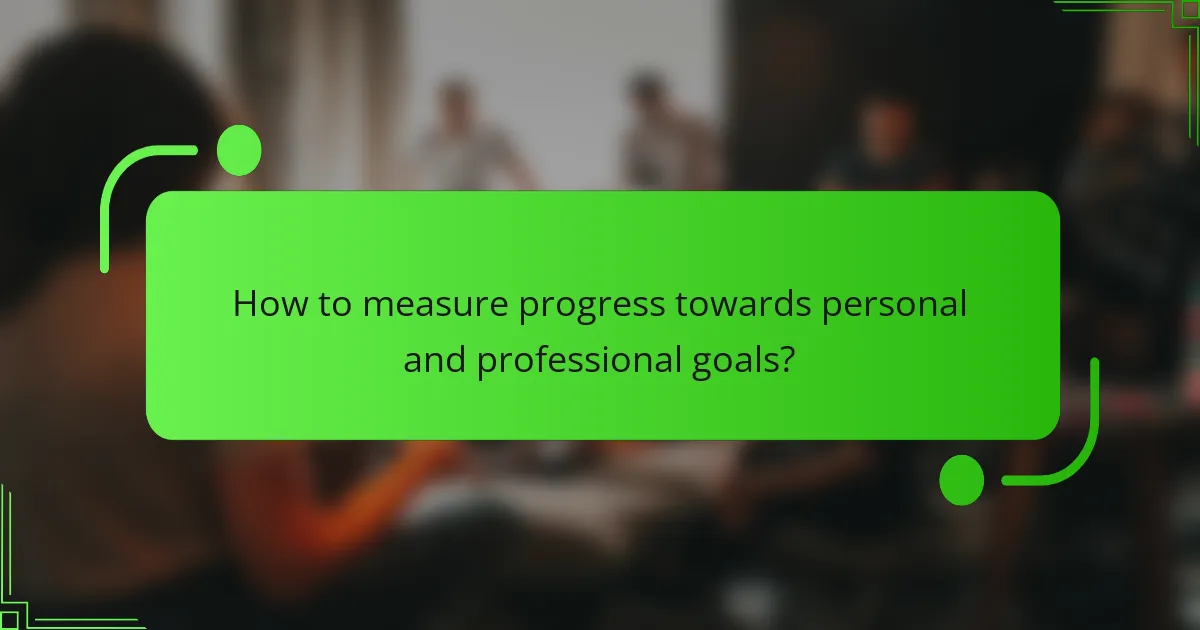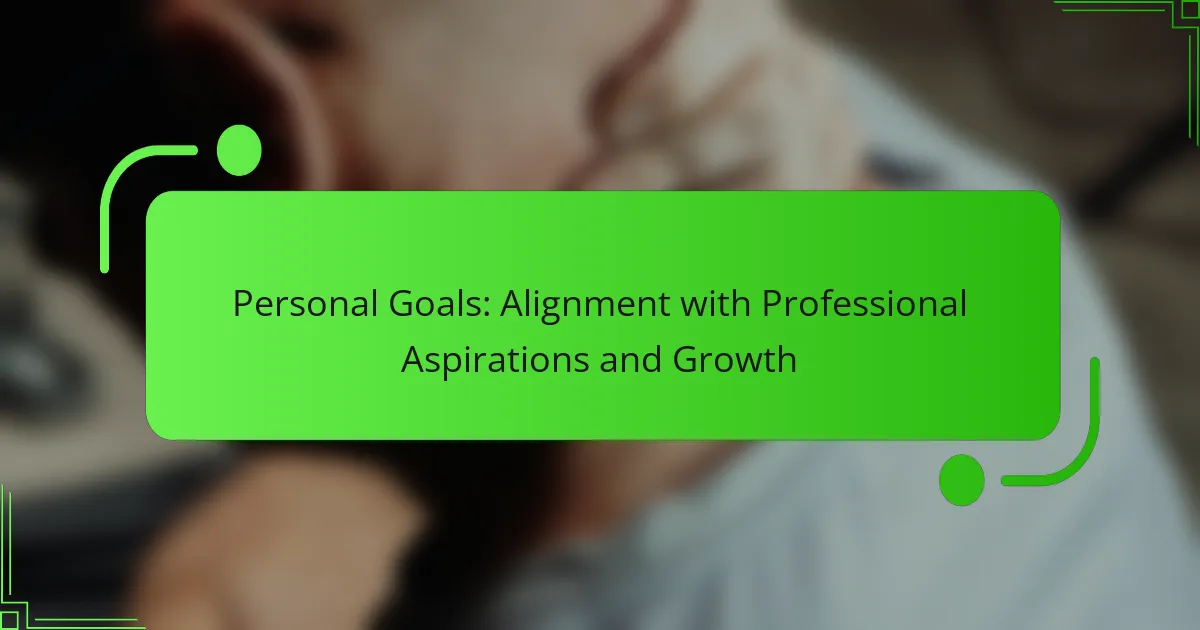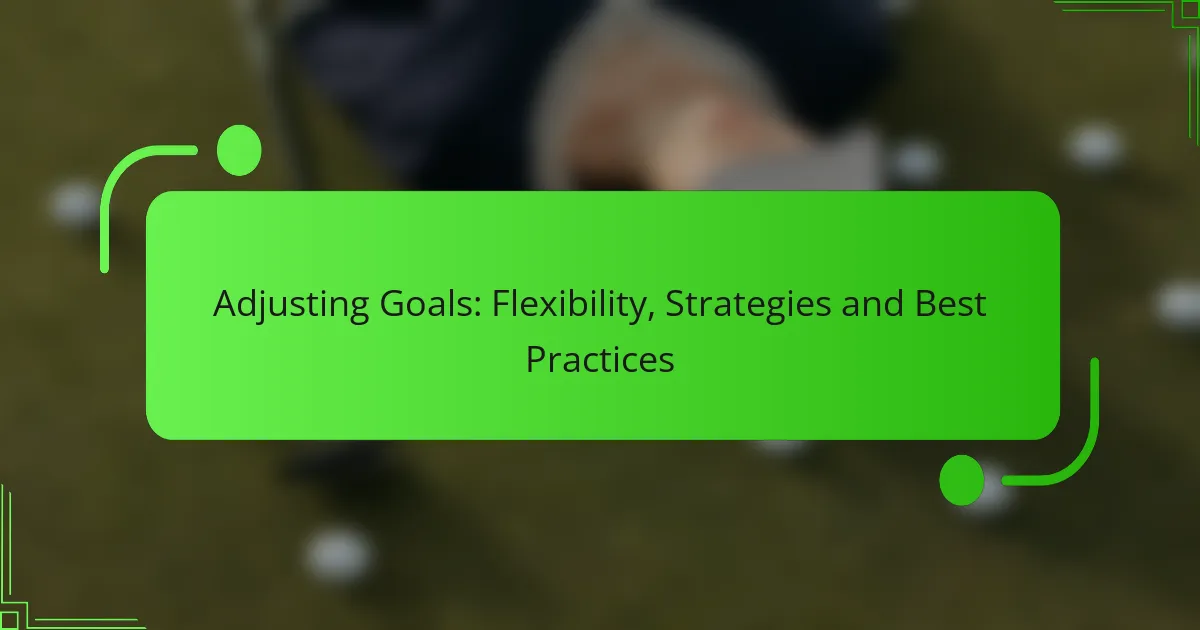Aligning personal goals with professional aspirations is crucial for achieving fulfillment and success in both areas of life. When individuals ensure that their values and ambitions are reflected in their career objectives, they are more motivated and engaged. By implementing effective strategies to create this alignment, individuals can pursue their goals cohesively, leading to greater satisfaction and measurable progress.

How can personal goals align with professional aspirations?
Personal goals can effectively align with professional aspirations by ensuring that individual values and ambitions are reflected in career objectives. When personal and professional goals are in sync, individuals are more motivated, fulfilled, and likely to achieve success in both areas.
Identifying shared values
Start by identifying your core values, as these serve as the foundation for both personal and professional aspirations. Consider what principles are most important to you, such as integrity, creativity, or teamwork. Aligning your career path with these values can lead to greater satisfaction and motivation.
For example, if you value community service, pursuing a career in non-profit work or social entrepreneurship may resonate more with you than a corporate role. Reflect on past experiences to pinpoint what has brought you joy and fulfillment.
Setting SMART goals
SMART goals are Specific, Measurable, Achievable, Relevant, and Time-bound, making them an effective framework for aligning personal and professional objectives. For instance, instead of saying “I want to improve my skills,” specify “I will complete a project management certification by the end of the year.” This clarity helps track progress and maintain focus.
When setting these goals, ensure they reflect both your personal values and career aspirations. Regularly review and adjust them as needed to stay aligned with your evolving priorities.
Creating a vision board
A vision board is a visual representation of your goals and aspirations, combining images, quotes, and other elements that inspire you. This tool can help clarify your personal and professional objectives, making them more tangible. Use magazines, online resources, or personal photos to create a collage that reflects your dreams.
Place your vision board in a visible area to serve as a daily reminder of what you aim to achieve. This constant visual cue can enhance motivation and keep your goals at the forefront of your mind.
Regular self-assessment
Conducting regular self-assessments allows you to evaluate your progress toward your personal and professional goals. Set aside time monthly or quarterly to reflect on what you’ve accomplished and where you may need to adjust your efforts. Consider questions like: Are my goals still relevant? Am I feeling fulfilled in my pursuits?
Use tools such as journals or apps to track your reflections and insights. This practice not only helps maintain alignment but also fosters personal growth and adaptability in your career.
Seeking mentorship
Finding a mentor can provide valuable guidance in aligning personal goals with professional aspirations. A mentor can offer insights based on their own experiences, helping you navigate challenges and identify opportunities that resonate with your values. Look for someone in your field who shares similar interests or has achieved goals you aspire to.
Engage in regular conversations with your mentor to discuss your goals and seek feedback. This relationship can help you stay accountable and inspired as you work towards achieving your aspirations.

What are effective strategies for goal alignment?
Effective strategies for goal alignment involve creating a clear connection between personal aspirations and professional objectives. This ensures that individuals can pursue their goals in a cohesive manner, leading to greater satisfaction and success in both areas.
Developing a personal mission statement
A personal mission statement articulates your core values and long-term vision, serving as a guiding principle for decision-making. To create one, reflect on what matters most to you and how these values align with your career aspirations.
Consider including elements such as your passions, strengths, and the impact you wish to make in your field. A well-crafted mission statement can help you stay focused and motivated, especially during challenging times.
Utilizing career development tools
Career development tools, such as online assessments and goal-setting frameworks, can help clarify your professional path. Tools like SWOT analysis (assessing strengths, weaknesses, opportunities, and threats) can provide insights into how your personal goals align with your career ambitions.
Additionally, platforms offering skills assessments or career mapping can guide you in identifying necessary steps to achieve your objectives. Regularly revisiting these tools ensures that you remain on track and adapt to any changes in your aspirations or the job market.
Engaging in networking opportunities
Networking is crucial for aligning personal and professional goals, as it opens doors to mentorship and collaboration. Attend industry events, workshops, or online forums to connect with like-minded individuals who share your interests and aspirations.
Building relationships with professionals in your field can provide valuable insights and opportunities that align with your goals. Remember to follow up with contacts and maintain these relationships to foster a supportive network that can help you grow.

How to measure progress towards personal and professional goals?
Measuring progress towards personal and professional goals involves tracking specific outcomes and evaluating performance against set benchmarks. This process helps individuals stay focused and adjust their strategies as needed to achieve desired results.
Setting key performance indicators
Key performance indicators (KPIs) are essential metrics that help gauge progress towards goals. When setting KPIs, ensure they are specific, measurable, achievable, relevant, and time-bound (SMART). For example, if your goal is to enhance your professional skills, a KPI could be completing a certain number of training courses within a year.
Consider both qualitative and quantitative indicators. While a quantitative KPI might track the number of projects completed, a qualitative one could assess the quality of feedback received from peers or supervisors. Balancing both types provides a comprehensive view of your progress.
Conducting quarterly reviews
Quarterly reviews are a structured way to assess your progress towards personal and professional goals. During these reviews, reflect on the KPIs you set and evaluate whether you are on track. This is an opportunity to celebrate achievements and identify areas needing improvement.
To conduct an effective review, prepare a summary of your accomplishments, challenges faced, and lessons learned over the past quarter. Use this information to adjust your goals or strategies for the next quarter, ensuring they remain aligned with your overall aspirations.
Using productivity apps
Productivity apps can significantly enhance your ability to track and measure progress towards your goals. Tools like Trello, Asana, or Notion allow you to set tasks, deadlines, and reminders, helping you stay organized and accountable. Choose an app that suits your workflow and integrates well with your daily routines.
Many productivity apps offer features like progress tracking and analytics, which can provide insights into your performance over time. Regularly review these analytics to identify trends, such as periods of high productivity or tasks that consistently take longer than expected, and adjust your approach accordingly.

What frameworks support personal and professional growth?
Several frameworks can effectively guide personal and professional growth, helping individuals align their goals with their aspirations. Two prominent models are the GROW model and the OKR methodology, each offering structured approaches to setting and achieving objectives.
GROW model
The GROW model is a simple yet powerful framework used for goal setting and problem-solving. It consists of four stages: Goal, Reality, Options, and Will, which help individuals clarify their objectives and develop actionable plans.
To apply the GROW model, start by defining your specific goal. Next, assess your current reality by identifying obstacles and resources. Explore various options for overcoming these challenges, and finally, commit to a course of action by determining your will to proceed. This structured approach encourages reflection and accountability.
For example, if your goal is to advance in your career, you might identify networking opportunities (Options) and set a timeline for attending industry events (Will). Regularly revisiting these steps can keep you aligned with your aspirations.
OKR methodology
The OKR (Objectives and Key Results) methodology is a goal-setting framework that helps organizations and individuals define measurable goals and track their outcomes. It emphasizes setting ambitious objectives paired with specific key results to measure progress.
To implement OKRs, start by defining a clear objective that is both inspiring and achievable. Then, outline 2-5 key results that will indicate success. This approach fosters alignment and focus, encouraging regular check-ins to assess progress and make adjustments as needed.
For instance, if your objective is to improve team performance, your key results could include increasing project completion rates by a certain percentage or enhancing team satisfaction scores. This method not only clarifies expectations but also motivates continuous improvement.

How can personal goals enhance workplace performance?
Personal goals can significantly boost workplace performance by aligning individual aspirations with professional responsibilities. When employees pursue personal objectives, they often experience increased focus, productivity, and job satisfaction, which collectively contribute to a more effective work environment.
Improving motivation and engagement
Setting personal goals can lead to heightened motivation and engagement at work. When employees have clear, meaningful objectives, they are more likely to take initiative and invest effort into their tasks. This intrinsic motivation often translates into better performance and a proactive approach to challenges.
For example, an employee aiming to improve their public speaking skills may volunteer for presentations, leading to enhanced communication within the team. This not only benefits the individual but also fosters a culture of growth and development among colleagues.
Fostering a positive work environment
Personal goals can contribute to a positive work environment by encouraging collaboration and support among team members. When individuals share their aspirations, it opens avenues for mentorship and teamwork, creating a sense of community and shared purpose.
Additionally, recognizing and celebrating personal achievements can boost morale. For instance, a team that acknowledges a member’s completion of a personal fitness goal may strengthen bonds and inspire others to pursue their own objectives, enhancing overall workplace harmony.

What role does feedback play in achieving goals?
Feedback is essential for achieving goals as it provides insights into performance and areas for improvement. It helps individuals align their personal aspirations with professional objectives, fostering growth and development.
Types of feedback
Feedback can be categorized into two main types: formal and informal. Formal feedback often comes from performance reviews or structured assessments, while informal feedback is typically spontaneous and can occur in day-to-day interactions. Both types are valuable, but informal feedback tends to be more immediate and actionable.
How to seek feedback effectively
To seek feedback effectively, be specific about what you want to know. Instead of asking general questions like “How am I doing?”, ask targeted questions such as “What can I improve in my presentation skills?” This specificity helps others provide more relevant and useful insights.
Incorporating feedback into your goals
Incorporating feedback into your goals involves regularly reviewing the input you receive and adjusting your strategies accordingly. Set aside time, perhaps weekly or monthly, to reflect on feedback and identify patterns or recurring themes. This practice ensures that you remain aligned with both personal and professional aspirations.
Common pitfalls to avoid
A common pitfall is becoming defensive when receiving feedback. Instead, approach feedback with an open mind and a willingness to learn. Additionally, avoid seeking feedback from too many sources at once, as this can lead to confusion. Focus on a few trusted individuals who understand your goals well.



